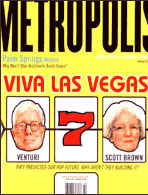 Metropolis
Metropolis
October, 2001
Feature Article: Hotel California
By Caryn B. Brooks
Photography by Misha Gravenor
This is a story about a hotel called the Orbit In that resides in a town called Palm Springs that’s located in a state called California. It is a place that almost immediately wraps itself around you, quite the opposite of the way large hotels in big cities make you feel anonymous and superior and too urbane for words. Passing through Orbit In’s front gate and stepping into a swank courtyard with a pool, a bar area, and Richard Schultz lounge chairs, you might get the giddy feeling of an 18-year-old about to take over the estate of a well-off friend while her parents trot off to Europe. Hooray!
Built in 1957 and resuscitated in 2001, Orbit In features nine guest suites plus a common room, each named and decorated according to a theme, including the Eames Studio, the Rat Pack Suite, and Bertoia’s Dan. Mid-century design fetishists – the ones who get tingly and sweaty-palmed while visiting the Herman Miller Web site- get to stay in rooms with real live furniture by the leading designers of the time (please no drooling on the Eero Saarinen Womb Chair).
But this is no purist rehab. There’s a commingling of designs that originated way back in the day with some from right here, right now. In Bertoia’s Den, a Blu Dot storage unit shares space with a Bertoia Bird Chair and a strictly twenty-first-century double-pillow-topped mattress that’s taller than most Bar Mitzvah boys. Many guests won’t use the original 1957 kitchenette, but they’ll enjoy knowing it’s there. Should visitors shuffle out to the courtyard for the continental breakfast, they can jack their laptops in next to the lava lamps at the boomerang-shaped bar. Nearby, classic Schwinn Cruisers stand ready to be taken out for a spin around the city. It’s the 1950s with all of the style, none of the icky social mores, and an added dash of useful technology. This is the world the Orbit In creates, and here is the story of how it came to be. You see, the Orbit In wasn’t always so welcoming. Before the sweet hand of fate swept down to save the place, it suffered from the criminal shabbiness and cried out for help from underneath tacky 1970s wallpaper. The following words and pictures will help you understand how a group of people came together to rejuvenate this neglected bit of architecture. It is an uplifting tale involving a good deal of happenstance and a little American ingenuity.
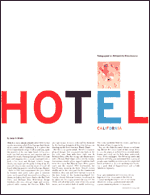
The Players
Palm Springs: Desert town two hours east of Los Angeles. During the middle section of the last century, this was a swinging city for Hollywood celebrities, and some just very rich and/or artistically inclined people. Many architects in the Modernist vein enjoyed building things here because of the austere environment, because rich people paid them to, and because it was a brand-new city with plenty of open space.
And yet the 1970s, 1980s, and most of the 1990s were not good to Palm Springs. Maybe it was because the town reminded all the tastemakers, debutantes, and A-list actors of their parents and/or the inevitability of aging and fading. Whatever the reason, Palm Springs was the one still sipping margaritas and doing the Macarena while everyone else was doing Ecstasy to drum-and-bass. But as with many things in the circle of life, Palm Springs was “rediscovered”. People who had taken a special interest in mid-century design, with its sublime use of line and materials (You! Yes you, reading this very magazine!), came back and claimed this mothballed city for their own. The well-nourished dot-com-mers, the well-appointed homosexuals, the well-intentioned architects all feasted their fangs on this town now ready for its close-up.
Orbit In: Sassy hotel with the tag line “the Palm Springs modern oasis.” Built in 1957 by Herbert W. Burns, it is one in a series of residential motels the designer/builder created for the Palm Springs visitor of the day, who-having braved the era’s primitively paved, non-air conditioned drive from Los Angeles- preferred to stay awhile. In July of 1999 Portland, Oregon entrepreneurs Christy Eugenis and Stan Amy bought the property from an 84 year-old man on oxygen. The place resembled the set of a Larry Clark photo shoot: a no-tell motel where it seemed some misdemeanor was on the verge of being committed at any moment. This state of neglect became its saving grace: having never been plowed over by a bland Home Depot renovation, its architectural details were intact and awaiting rediscovery.
Christy Eugenis: First-time hotel owner and lead visionary behind Orbit In. Eugenis has clocked in careers as a real-estate agent, sportswear designer, and vintage-clothing store owner. She discovered the property, then known as the Village Manor, while rollerblading around Palm Springs in search of investment properties. Her husband, Stan Amy, had expanded a natural-food supermarket into a wildly successful chain; now the couple wanted to invest (and vacation) in a sunny area that was a quick plane trip from their base in Portland. Of her affinity for mid-century modern she says, “It’s fun and functional, and it’s stylish and simple.” Indeed. It is out of this combination of enthusiasm and capital that the Orbit In came into being.
Lance O’Donnell: Architect who grew up in a Modernist home near Palm Springs. His firm, O’Donnell + Escalante Architects, is known for projects completed at the behest of the local American Indian community, including Tahquitz Canyon Interpretive Center and the Cahuilla Indians’ Community Center. O’Donnell saw rejuvenating the tired Village Manor property as a way to counteract the razing of Modernist buildings going on elsewhere around town. “It was like an aging Hollywood starlet” he says. “She’s got great bone structure. Her ears may be touching, but she’s still beautiful underneath it all.
Albert Frey: Well-known and now dead Modernist architect who lived for a long spell in Palm Springs. His second home overlooks Orbit In, and his legacy infiltrated the city much like the Ghost of Christmas Past.
The Plot:
This plot, like many good ones, involves a quest: tweaking a run-down Modernist hotel with “great bone structure” into a modernized Modernist hotel for the NEXT MILLENIUM. If you are lucky enough to buy such a property, what do you keep, what do you add, and what do you throw away?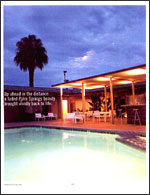 Act I, The Exteriors:
Act I, The Exteriors:
- From the get-go Eugenis know she wanted the courtyard to be a social environment. Previously there was just a patch of dead grass beside the pool. Using what might be termed the “Cheers formula,” the team built an interaction area that trades that woody Boston hub for a terrazzo bar by Seattle artist Kevin Spitzer.
- When the pool was built, lawsuits were not the sport they are today, thus it had a diving board and a deep-end lice that dropped ten feet. “It was scary just looking at it,” recalls hotel general manager Bruce Abney. At the same time, there were landscaping issues to deal with, including an ugly 1970s condo next door, overlooking the courtyard. The solution was to build a shallower pool, and move it 4 feet, leaving room for a high wall and landscaping; Carolina Cherry trees now obscure the offending condo.
- Protecting sight lines was also important when it came to the back of the hotel. As it stood, if you opened the rear door from any of the kitchenettes, you were faced with a chain-link fence. Eugenis says there was a need for what she calls “continuity and privacy.” To this end, O’Donnell created individual patios behind most of the suites. Polished-concrete block walls block the view of a barren lot and offer guests an opportunity to hang outside without joining the courtyard scene.
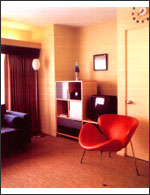 Act II, The Interiors:
Act II, The Interiors:
- The rooms were less of an open field but had their hidden gems. After several rounds of serious scrubbing and re-grouting, Eugenis had two great details worth keeping: white enamel kitchenettes and bathrooms tiled in frosty pink.
- While fixing the built in wall clocks, Eugenis and Abney noticed an inscription on a casing that read “American Clock Co.” and decided to see the manufacturers help. One exciting phone call later, they discovered that the company not only still existed but had kept the original clock templates designed for this and many of Burns’ other properties. They ordered an assortment.
- When the original electric heaters in the rooms were removed and replaced with central heating, they left a hole the size of a large sheet cake. Instead of plastering them over, O’Donnell suggested they turn the indents into magazine racks: twin powers form and function activated!
- Though they’re not exactly on the cusp of a stylistic revival, fifties drapes were worth bringing back if only because hotel rooms must offer permanent midnight. Eugenis chose to go with Eames fabric valances custom made by a draper who’s been working in Palm Springs 40 years.
- The pile carpet of the modern era, on the other hand, still doesn’t have any benefits to recommend it. Eugenis found that sea-grass floor covering from Design Materials Inc. cleans up the look of the rooms and shows off the furniture better.
- Eugenis also got to spend a year and a half collecting furnishings. She started by looking for authentic pieces in Palm Sprnigs, acquired a few more in Portland, and the relied on interior architect Paul Nadolny of UrbanEase (in Seattle) to help select new originals such as coffee tables by Eames and Noguchi. Orange slice, Bikini Pad Wire, and Diamond chairs – and a framed Bertoia sketch- all became part of the package.
- As noted earlier, Albert Frey’s second home, now owned by the Desert Museum, is nestled in the hill that rises behind the hotel. In homage to this Modernist master, the Orbit In offers the Frey Lounge, with cabinets styled after those inside the venerable casa. How’d they do it? You need an appointment to visit the house on the hill. When Eugenis secured one, she grabbed her cabinetmaker to come with her and study the design so he could bring its inspiration to the Orbit In.
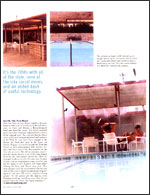 ACT III, The Next Hotel:
After the Orbit In was all put together, Eugenis found a 1948 issue of Architectural Record with a story on the “Town and Desert”, a Burns-designed hotel just down the street. The article featured photos by Julius Shulman and provided evidence of the original style. She realized that the decorative poles and the textured plywood wall surfaces at the Orbit In must have been original to the design, for there they were in the Town and Desert. (Eugenis eventually bought the Town and Desert as well; unfortunately both of these features had been erased from that property by the time she got it.) She felt an uncanny connection: the article showed some of the same Eames furniture she had picked out for the Orbit In, arranged in almost exactly the same way. A sense of peace and accomplishment came over her, but not the signal to rest. Eugenis will begin refurbishing the Town and Desert next year. “I’ve been pleased with the environment that we created and the way in which our guests are responding to it.” she says. “Of course, a hotel is a living project. As the guests use the spaces, we’re learning, tweaking, and filing away ideas for our project down the street. The quest continues.”
ACT III, The Next Hotel:
After the Orbit In was all put together, Eugenis found a 1948 issue of Architectural Record with a story on the “Town and Desert”, a Burns-designed hotel just down the street. The article featured photos by Julius Shulman and provided evidence of the original style. She realized that the decorative poles and the textured plywood wall surfaces at the Orbit In must have been original to the design, for there they were in the Town and Desert. (Eugenis eventually bought the Town and Desert as well; unfortunately both of these features had been erased from that property by the time she got it.) She felt an uncanny connection: the article showed some of the same Eames furniture she had picked out for the Orbit In, arranged in almost exactly the same way. A sense of peace and accomplishment came over her, but not the signal to rest. Eugenis will begin refurbishing the Town and Desert next year. “I’ve been pleased with the environment that we created and the way in which our guests are responding to it.” she says. “Of course, a hotel is a living project. As the guests use the spaces, we’re learning, tweaking, and filing away ideas for our project down the street. The quest continues.”